#Monolith: Relics of the Past
Conversation
Ordinator, holding Firewall over his head: BEHOLD, A NEW KILLING MACHINE OF WAR
Rest of the council: Ordinator, this is the 8th killing machine of war this week.
#Monolith: Relics of the Past#monolith: after the end#Ordinator#source: jimmy neutron#thank you celesteela
3 notes
·
View notes
Text
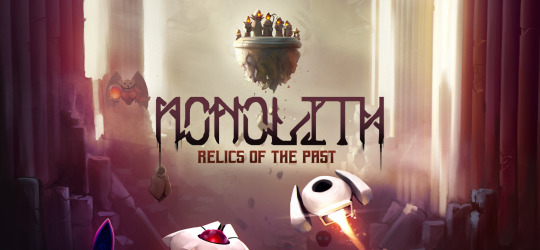
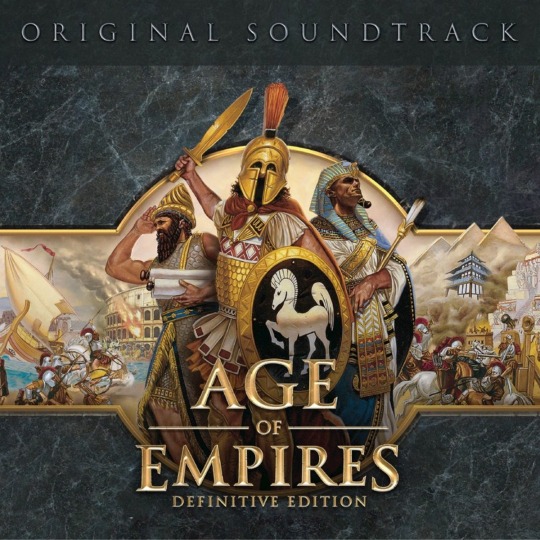
9 notes
·
View notes
Text
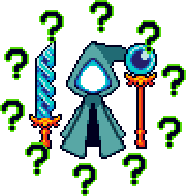
new blorbo just dropped
1 note
·
View note
Text
Stop Being Weird About Indians
Let’s talk about virtue signalling when talking about American Indians and how it’s doing more harm than good. I saw a take that writing about Kaia, an indigenous character in Supernatural, in fanfiction is a cancel-able offense because the way she’s depicted in the show is problematic. I’ve heard similar things about the skinwalkers in Teen Wolf - I’ve also heard that you shouldn’t even type the word “skinwalkers” because it’s offensive, which... I’m not gonna go into all the details, but that’s a gross misunderstanding of the belief around the word, and also the actual word the belief is about - you won’t believe this - isn’t an English word.
Anyway.
The topic of indigenous oppression in the US is complicated, but one of the fundamental issues, which actual indigenous activists (not just keyboard warriors) constantly talk about, is the way indigenous people are ignored and erased from the story. It’s called “The Terminal Narrative.” Text books talk about indigenous people like they’re a relic of the past, like they’re all dead and gone. (Do you know how weird it is for Indian children on reservations to read a US history book that implies they don’t exist?) Human rights abuses and social issues on reservations are left out of the conversation or skimmed over as if they’re too obscure to be fully understood, or like they impact so few people, it doesn’t really matter.
Policing wording is not activism. Sharing call-out posts isn’t activism. You are not doing anything to help anyone. You’re not funding, volunteering, calling politicians, or doing any actual work to better the lives of indigenous Americans. (Before anyone calls hypocrite, I do work with an indigenous rights group IRL.) When someone scolds another person online over using a word that isn’t PC, 99% of the time it’s clear they don’t actually care - they derive a sense of moral superiority from knowing the “correct” way to speak. And they don’t care about the chilling effect it has on speech overall. This naturally leads to one of the most toxic elements of liberal conversations about race: that you must have the conversation perfectly or not at all. And that’s the impact it has. People just stop talking about it for fear of being wrong.
Can you see how, in a society where indigenous oppression is actively facilitated by silence and erasure, making people afraid to speak about Indians is one of the worst things you could possibly do?
It’s become standard fare for Indian Studies books to start with a disclaimer explaining that “Indian” actually isn’t an offensive word and is the word that most indigenous people use for themselves. The disclaimer isn’t because it’s new or radical information. It’s because white Americans are so goddamn weird about virtual signaling about ~The Native Americans~ that they would condemn a much-needed book of scholarship on native issues just for using a word that they thought was offensive.
Native people aren’t a monolith. You’ll find Indians that insist you need to spell it NDN or that XYZ is offensive. Production companies can pay a native person to come tell them they’re allowed to write about something most people from their tribe would find offensive. Fact of the matter is, a lot of Indians are not experts on like... heritage culture. If they grew up on a rez, they can tell you about rez culture, but they’re not all Indian Studies scholars, the same way not all Irish people are experts on Celtic paganism. Not all Indians are experts on indigenous politics, the same way not all Americans are experts on American politics. And it goes without saying that a GODAWFUL amount of the people lecturing on acceptable ways to interact with indigenous characters are not only uninformed about indigenous issues (I saw one post where someone clearly linked the first thing that came up when they googled “Native American drug addiction”) but are also not indigenous themselves.
And, yes, the vast majority of depictions of Indians in American media are problematic in one way or another, but saying that the solution is to erase indigenous characters from fandom entirely (because they’re all problematic) is the absolute WORST conclusion to reach. Fix the characters if you care that much! Give the Teen Wolf skinwalkers names! And an iPad! Let Kaia be the master of her own destiny! Let her bitch Dean out for pointing that gun in her face! Let her live happily ever after with her girlfriend! What the hell is fandom for if not fixing the issues we see in canon? Why are we allowed to reclaim and rewrite problematic queer characters but not problematic native characters? Who is that serving? Because it sure as hell isn’t serving Indians.
Anyone that tells you it’s better to ignore Indians than say the wrong thing about them is, knowingly or not, actively promoting a terminal narrative and the continuation of indigenous genocide.
366 notes
·
View notes
Note
can i ask you something? i dont know how to word it without coming off offensive however i am curious as to what trans men think about manhood as a concept. i consider myself to be pro-trans rights but as I've learned more about gender and sex, I've started to interpret male/female binaries as being inherently rape culture compliant (not the individuals who partake in gender/sex as a construct, just the construct itself like as a concept). my question is i understand the whole concept of positive masculinity but also i genuinely cannot come up with any set of qualities that are inherently and only masculine (also have the same problem with feminine qualities). like every man (not just trans, cis too) who wants to deconstruct masculinity ends up sounding a little sexist to me because i just do not know how something like idk "protectiveness" can be seen as only masculine. the way i view gender (and sex) honestly is mostly as a relic of the past but i dont know if this line of thinking is transphobic or not. bcuz i dont want trans people to not exist or not be trans, i welcome it while humanity is in this transitional period but i also think that gender neutrality is/should be the norm. i hope this wasnt offensive or anything, you dont have to respond or anything i just would like to know more i guess and understand better.
Well, luckily I'm able to read things in good faith, regardless of the actual words used. It's hard to discuss things sometimes without coming across as a dolt, especially if you're struggling with a concept as complex as gender identity.
I've been going back and forth on how to reply to this because I could like. Respond with a detailed breakdown but I'm not sure it'll help you, not really.
Because look at how you write. You're coming at this from like this inherent idea that men as the villains. Rape culture is a particular tell, as rape culture focuses on women as victims and minimizes/erases male victims. Meanwhile, since 2008, when I first became truly aware of how often women are victims of assault and harassment, the statistics on male victims have been slowly creeping up to meet female statistics. Rape culture is also a phrase I personally find adjacent to SWERF rhetoric, as they have this idea that all sex work is inherently rape, regardless of the actual autonomy of the women (never the men) in the situation.
You also focus on how masculinity and men deconstructing gender come across as sexist, with little thought to how women are just as sexist when it comes down to it. There are a lot of problems within feminism, and it's something we see clearly as they constantly have to redefine what a woman is as they acknowledge (or refuse to acknowledge) the different experiences of womanhood.
I'm not blaming you for this. Feminism makes dissecting womanhood and villainizing manhood the default for almost all discussion, and there's been a lot of work done to allow for a diverse array of women to exist in the world. Masculinity and manhood though, it's hard to pull it apart from the villainization that's been done to it. Because honestly, it's easier to demonize men than it is to deal with the fact the reality that the true villain is the very societal framework we exist in (capitalism).
I realize I'm probably not making all that much sense right now. But while I largely agree with you that we are heading down the long and arduous path of decoupling the idea of gender entirely from existence, becoming something we may choose for ourselves rather than something given to us at birth, I disagree with how your thought patterns betray your current biases.
Trans men, and indeed men at large, are not a monolith, nor are women or nonbinary people or agender or genderqueer identities. We are all at the faults of whatever framework we approach it from, and largely the group I am part of speaks from a very Western idea of gender. The fun part, though, is deciding what your gender means to you. Which is why I do see myself as a protector, very stereotypical, but I love glitter and silly and goofy bright musicals and magical girl stuff. I don't wear skirts or dresses, but maybe I'll pick a romper. And I work very very hard to see more than just my side of a story and don't try to make a list of "what is wo/man" cause honestly, I don't see the point.
This is my positive masculinity. I wonder what my followers see as theirs.
#transandrophobia#transgender#transsexual#transmisogyny#trans man#nonbinary#exorsexism#trans woman#agender#genderqueer#idk what else to tag this is I'm due in class
17 notes
·
View notes
Text
Monolith: After the End is getting renamed to "Star of Providence"
If you get the game now, you can get the Relics of the Past expansion for free, because the new version will include the expansion by default.
Partially because it added so many improvements they felt it's better to make it one package.
The game is really cool and fast, and pretty forgiving I would say.
#Monolith After the End#Star of Providence#roguelike#indie games#steam sale#mugenfinder gaming#loud#Flashing Lights#tw flashing
19 notes
·
View notes
Text
bro there is something about bdubs obsession with time, especially as it relates to the past, and his tendency to keep digging up the bones of lost people and lost projects. whether its thru storytelling with his builds (the monolith being an ancient building repurposed, the ruins and trials hes scattering around the server) or in the literal sense of him reviving the horse course, naming videos with old titles. its his obsession with reworking the timeline by giving abandoned things new meaning and giving another shot to things that didnt stand the test of time. its how he sleeps through the night to fast forward time, but spends the day refurbishing relics to make time slow down.
#he makes me so fucking insane#writes a paper on bdoubleo writes a paper on bdoubleo writes a paper o#bdoubleo100#bdoubleo#hermitcraft
73 notes
·
View notes
Text
Cang Du Backstory, Goals & Some Headcanons
-
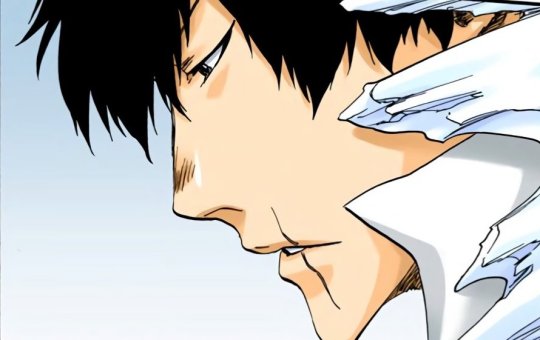
( Some thoughts of the man of iron. So sad that he had a short appearance. He, and other Quincies DESERVE some backstory like how Kubo did to the Arrancars and the beloved Shinigami )
BACKSTORY
- Cang Du is actually in his mid 20s’ and was born and reside in the Monolith village. The village itself was one of the most isolated ones in China.
- He is actually well versed with ancient relics and scrolls.
- Will probably ended up as an archeologist if he was born under normal circumstances.
- He is actually a prodigy for his age but retained his down to earth nature due to his realism view.
- As a child, he was always a quiet boy. He learnt some basic martial arts from his relative ( probably Uncle), so his introvert nature won’t attract any annoying pests or potential bullies. He prefers to be in his own thoughts than being surrounded by people. He enjoyed taking a stroll by the forest to breathe the fresh air and the soothing silence.
- He either being with his parents, single parent or single relative.
- He actually grad with DEANS LIST for the said archeologist course. Masters with full scholarship as he is a very self sufficient man.
- He mostly spent time alone or doing odd jobs like working as a librarian or a bodyguard at any random warehouse for some free time and some extra cash. Trust me, like no one had a clue regarding him. He just do his job and behave in exchange to be left alone.
- His family was basically a traditional one in a good way as Cang Du seemed to disagree with the polygamy of the Emperor in the past.
- His family probably left the world when he is around late teens, making the poor man more lonely as by then, he adopted a nomadic lifestyle.
GOALS
- Cang Du actually discovered his powers when he was around 5 but he kept it a secret from his family to prevent them from being concerned.
- He knew despite loving his powers, the society considered it as some kind of mutation so he self taught on how to manage and control his power.
- He learnt some history regarding Quincies from one of the scrolls and learnt that his late grandfather from his mother side is a Quincy himself.
- He enjoyed being in solitude but a small part of him felt lonely, unwelcomed in the human world.
- When one of the Quincies ( Probably Gerard or Lille ), approached him and offer a place in one of the elite forces, Cang Du quickly jumped in, felt relief that he had a purpose regarding his origins.
- He did not mind it being fascist and militaristic. He is an unapproachable and silent guy so it did not effect him one bit. He just steer clear of any issue, do his job and he can do whatever he want.
- Like most Sternritters, he too have a mind of his own. However, one of the main reasons he respected Yhwach was due to the latter gave him a purpose over a lonely life.
HEADCANONS
- I always see him as a male version of Annie Leonhardt from SNK/ AOT.
- He is actually a naturally handsome guy so believe me when I say many women actually fawn over him but he remained oblivious to it.
- If Cang Du is a normal soldier, Bambietta probably would hit on him but she knew any feud with other Sternritter is punishable by death.
- In his university days, some women left him some letters but he either side read them or did not bother by it and left it under spider web lockers.
- Candice actually tried to strike a conversation in attempt to try to decently know him, but Cang Du usually respond with one/ two words or with gestures before it ended in uncomfortable silence. Candice usually sweat dropped as Cang Du walked away from the place.
- Bazz B tried to strike conversation with him but like Candice, he either gave a few words of responds or gestures. He also gave a look as a sign to stop. Bazz B also tried to ask him for drinks and teased him as some women find him attractive but he hardly took note of those.
- Was probably in cordial terms with others like Gremmy and As Nodt.
- Cang Du is a virgin 150%. He was one of those man who hardly give a thought and just steer clear from human contact. He probably doesn’t know what sex is so when at rare time where he needed to relief himself, he do it very briefly and quietly as he often felt awkward.
- Mask De Maculine and Askin are two eccentric goodies but he was just on good terms with both of them.
- If some women or waiter try to make a move, he swiftly move away or politely state his disinterest with being in a relationship. I do see it sometimes happen and that’s why Bazz B make fun of him.
16 notes
·
View notes
Text
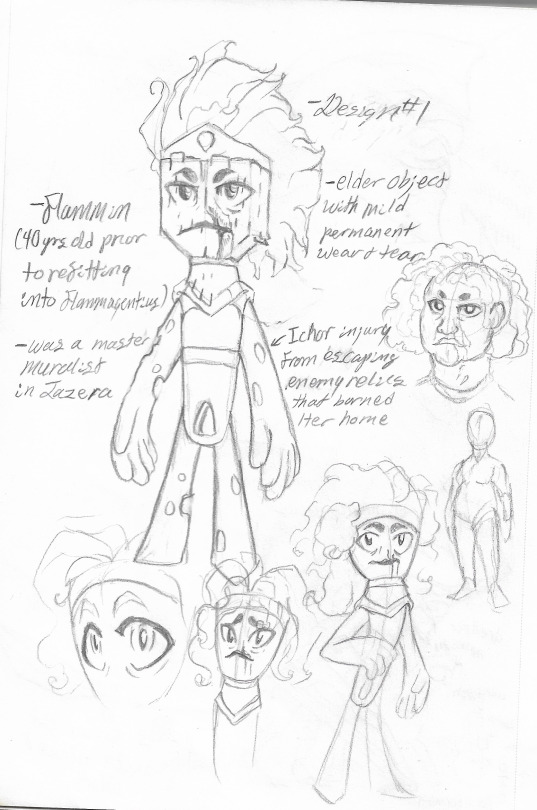
Another Flammagenitus Flammin Sketch
Also, here's what Flammagenitus looked like as Flammin before she is later refitted into a war-torch monolith. There is also a sketch of her as a human, a dreamform Queen Nike helped create for her.
Flammin was an elderly living paintbrush. As shown here, the surface of her wooden core is rough from permanent wear and tear. Their bristles are short and straggly from past use. Flammin was a senior muralist back before their kingdom, Jazera, was destroyed by enemy relics. The holes in her ichor limbs and the permanent scar on her face were from her escape when her kingdom burned.
One day, she will return that hateful flame to those who wronged her.
Flammin as Flammagenitus
More on Flammagenitus
#characterdesign#character design#objectoc#object ocs#worldofrelics#themundanerealm#objectxenofiction#xenofiction#tmr flammagentius#tmr flammin#not final design tho#needs more development
5 notes
·
View notes
Note
Happy World-Building Wednesday! On the unexplored parts of maps, one might find the words "Here there be monsters". I'm here to ask what yours are. What lurks in the unexplored areas of your world?
VERY late on this but ty for the ask!!
So These Barren Wilds is set in a post-environmental apocalyptic world, in what remains of the western USA. People ate the Earth. They ravaged her with heat and pollution, and the effects of this are SUPER prominent the more inland you go.
An unforgiving desert. Hard, scorched earth. Piles of debris and garbage that tower up up up.
And despite this desecration to her surface, the Earth still gives back — even when no one wants her to.
In the barren wilds (the scorched, unliveable stretch of land east of current civilization), massive sand dunes shake and rattle every now and then, regurgitating relics from the past. A VW crusted in rust. Monolithic bones from an ancient creature called a "whale."
And, for the first time ever (which drives the premise of the story): a living man.
taglist; @digital-chance @ntzsche9
5 notes
·
View notes
Quote
The risk I took was calculated but, man, am I bad at math.
Trespasser, Null, Chaosgod, Machine, Anarchist, Ordinator
#Trespasser#Null#Chaosgod#Machine#Anarchist#Ordinator#Monolith: Relics of the Past#source:the mincing mockingbird
2 notes
·
View notes
Text

In the year 2274, amidst the sprawling megalopolis that humanity had built, there was a forgotten patch of earth where time seemed to slow, and the air thrummed with ancient secrets. It was known as the Stanley Price Weir Zone, a field dotted with monolithic structures that had mystified people for centuries. Unlike its ancient counterpart, Stonehenge, this was a place of both history and future, where relics of the past stood sentinel to the progress of mankind.
The Zone was under the guardianship of Alia, a being not entirely human. Her DNA was spliced with that of the long-extinct architects of the monoliths, granting her the wisdom of the ancients and the insight of the modern world. Her appearance was a stark reminder of her dual heritage—a crown of corroded technological artifacts adorned her head, suggesting a bygone era of greatness, and her skin was etched with circuit-like patterns, a blueprint of forgotten knowledge.
Alia's charge was to protect the Weir from those who sought to exploit its energies for war and destruction. The monoliths were more than stone; they were ancient devices capable of bending the fabric of space-time, a gateway to the stars and perhaps even to alternate dimensions.
Enter Cade, a relic hunter with eyes the color of the stormy skies, whose past was as shrouded in mystery as the Zone itself. Driven by the need to save his dying world from the energy crisis that threatened to plunge it into darkness, Cade sought the secret power of the Weir. His path led him to Alia, whose very existence was intertwined with the stones he so desperately needed.
They met under the gaze of the timeless monoliths, a dance of destiny weaving them together. Cade, with his rough charm and relentless determination, clashed with Alia’s ethereal calm and unwavering resolve. Yet, beneath the conflict, there was a current of understanding, a recognition of kindred spirits.
Together, they uncovered the true potential of the Stanley Price Weir—the ability to harness the cosmic winds, channeling the energy not for war, but as a source to rejuvenate their dying planet. It was a gift from the ancients, a means to end the energy crisis, and a chance to unite a fractured humanity.
But such power did not come without its dangers. A shadowy faction from the United Corporations, led by the enigmatic Magnus, eyed the Weir with avarice. Their agents were closing in, ready to claim the power for themselves and to control the fate of all.
Alia and Cade stood as the last line of defense, embroiled in a battle that transcended time. With the heart of the Weir pulsing around them, they harnessed its energy in an epic standoff. The monoliths glowed like beacons, creating a shield that protected the sacred ground from those who would do it harm.
As the dawn of a new day painted the sky with hues of hope, the United Corporations retreated, their ambition thwarted by the combined might of Alia and Cade.
In the aftermath, Alia and Cade realized that their destinies were not only interwoven with each other but with the fate of the world itself. The Stanley Price Weir stood testament to their victory, a reminder that the future was built on the foundations of the past, and that the guardianship of such power demanded unity and understanding.
And so, as they walked away from the Weir, the knowledge of its secrets safe once again, they did not speak of goodbye. For in the world of tomorrow, where the past and future merge, there are no farewells, only the infinite possibilities of the cosmos.
0 notes
Text
Play monolith after the end and its dlc, monolith relics of the past. They are hidden gems that desperately need more attention.
1 note
·
View note
Text
Unleashing the Power of Innovation: Legacy Systems Modernization Strategies

In today's rapidly evolving digital landscape, organizations often find themselves grappling with the challenges posed by legacy systems. These aging infrastructures, while once revolutionary, can now hinder agility, scalability, and innovation. However, rather than viewing legacy systems as burdensome relics of the past, savvy enterprises are embracing modernization strategies to unlock their hidden potential and drive business growth.
Embracing Incremental Modernization Approaches
One effective strategy for modernizing legacy systems involves adopting incremental approaches. Instead of undertaking massive overhauls, organizations can break down modernization initiatives into manageable chunks. By prioritizing critical functionalities and business processes, they can gradually migrate or refactor components of the legacy system while ensuring minimal disruption to operations. This iterative approach allows for continuous improvement and adaptation to changing business needs.
Harnessing the Power of APIs and Microservices
Another key modernization strategy revolves around leveraging APIs (Application Programming Interfaces) and microservices architecture. By encapsulating legacy functionalities into APIs, organizations can expose these capabilities to modern applications and platforms, enabling seamless integration and interoperability. Microservices architecture further enhances agility by breaking down monolithic legacy applications into smaller, independently deployable services. This decoupling of components facilitates scalability, flexibility, and easier maintenance.
Adopting Cloud-Native Solutions
Cloud computing offers compelling opportunities for modernizing legacy systems. By migrating legacy workloads to cloud environments, organizations can take advantage of elastic scalability, pay-as-you-go pricing models, and a wealth of managed services. Cloud-native technologies, such as containers and serverless computing, provide the foundation for building scalable and resilient applications. Moreover, cloud platforms offer robust security features and compliance certifications, addressing concerns around data protection and regulatory requirements.
Embracing DevOps and Agile Methodologies
Modernization efforts are greatly enhanced by embracing DevOps practices and agile methodologies. DevOps fosters collaboration between development and operations teams, streamlining the software delivery pipeline and accelerating the pace of innovation. Agile methodologies, such as Scrum and Kanban, promote iterative development, allowing organizations to quickly respond to changing requirements and market dynamics. By adopting a culture of continuous improvement and automation, organizations can drive efficiency and innovation in their legacy system modernization endeavors.
Conclusion
Legacy systems modernization is not merely about replacing outdated technology; it's about embracing innovation and leveraging the strengths of existing systems to fuel digital transformation. By adopting incremental approaches, embracing APIs and microservices, leveraging cloud-native solutions, and embracing DevOps and agile methodologies, organizations can embark on a journey of modernization that unlocks new opportunities, enhances competitiveness, and ensures long-term success in today's dynamic business landscape.
#legacy system#system decommissioning#carve-out#it application decommissioning#mergers and acquisitions#sap system#insolvency#liquidation
0 notes
Text
Unleashing the Power of Cloud-Native Application Development

In today's digital landscape, where agility, scalability, and efficiency are paramount, businesses are increasingly turning to cloud-native application development to gain a competitive edge. With the rapid evolution of cloud technologies, traditional monolithic applications are becoming outdated relics of the past. Instead, organizations are embracing the cloud-native approach to build applications that are inherently scalable, resilient, and flexible. In this blog, we'll explore the essence of cloud-native application development, its benefits, and how it's transforming the way we build and deploy software solutions.
Understanding Cloud-Native Application Development
Cloud-native application development is more than just deploying applications in the cloud. It's a methodology that leverages cloud computing principles to design, develop, deploy, and manage applications. At its core, cloud-native development focuses on building applications as a set of loosely coupled microservices, each running in its own container and independently deployable. This architectural style enables faster development cycles, greater scalability, and improved resilience compared to traditional monolithic applications.
Key Characteristics of Cloud-Native Applications
Microservices Architecture: Cloud-native applications are composed of small, independent services that can be developed, deployed, and scaled independently. This modular approach enables teams to iterate faster and adapt to changing business requirements with ease.
Containers: Containers provide lightweight, portable, and consistent runtime environments for individual microservices. Technologies like Docker and Kubernetes have become instrumental in managing containerized applications at scale, enabling seamless deployment and orchestration across cloud environments.
DevOps Practices: Cloud-native development emphasizes automation, collaboration, and continuous integration/continuous delivery (CI/CD) pipelines. DevOps practices enable teams to streamline the development process, increase deployment frequency, and improve overall software quality.
Resilience and Scalability: Cloud-native applications are designed to be resilient to failures and scalable to handle fluctuating workloads. By leveraging cloud infrastructure and auto-scaling capabilities, applications can dynamically adjust resources based on demand, ensuring optimal performance and availability.
Benefits of Cloud-Native Application Development
Improved Agility: Cloud-native development enables faster time-to-market by breaking down complex applications into smaller, manageable components. This agility allows teams to quickly respond to customer feedback, iterate on features, and stay ahead of the competition.
Enhanced Scalability: With the ability to scale each microservice independently, cloud-native applications can handle varying levels of traffic and workload demands more effectively. This scalability ensures consistent performance and a seamless user experience, even during peak usage periods.
Cost Efficiency: By leveraging cloud resources on a pay-as-you-go model, organizations can optimize infrastructure costs and avoid over-provisioning. Cloud-native applications are designed to use resources efficiently, minimizing waste and maximizing ROI.
Increased Reliability: The distributed nature of cloud-native architectures inherently improves reliability and fault tolerance. With built-in redundancy and failover mechanisms, applications can withstand failures gracefully, ensuring uninterrupted service for end users.
Conclusion
Cloud-native application development is revolutionizing the way organizations design, build, and deploy software solutions. By embracing cloud-native principles, businesses can unlock unprecedented levels of agility, scalability, and efficiency, enabling them to stay competitive in today's fast-paced digital economy. Whether you're a startup looking to disrupt the market or an enterprise seeking to modernize your IT infrastructure, embracing cloud-native development is the key to unlocking innovation and driving business success in the cloud era.
0 notes
Text
Explore Seamlessly with Chennai Car Rental Service
Chennai is a treasure trove for all types of culture, historical sites, and exciting suburbs. Experience deep relaxation and explore the beauty of this coastal mega-city by taking advantage of Chennai rental services. This blog will examine the advantages attached to car rental services in Chennai as well as list out a few destinations that are also made easily accessible by appropriate vehicles.
Places to Visit in Chennai
1. Marina Beach
Marina Beach, situated along the Bay of Bengal, is much more than just a broad shore. Start your journey in Chennai by taking a casual seaside trip at this breezy seashore, walking along the Marina Promenade, and admiring the lively local culture. Food vendors are scattered along the beach, serving local dishes for one to savor Chennai’s cuisine by the seafront.
2. Kapaleeshwarar Temple
The Kapaleeshwarar temple, which lies at the heart of Mylapore, demonstrates how culturally diverse Chennai truly is. Head there with a Chennai car rental service and see firsthand those amazingly crafted gopurams, as well as enjoy the divine atmosphere. It is one of the holy places dedicated to Lord Shiva.
3. Elliots Beach
If you seek to have a peaceful coastal ride, then you need to take a short-distance journey from Marina Beach to Elliot’s Beach in Besant Nagar. The calm stretch of shoreline provides an ideal setting for relaxation, and there are attractive street restaurants along the promenade. Go for a scenic ride along the coast, discover the lively district of Old Town, and experience the spectacular sea at sunset.
4. Fort St. George
Visit Fort St. George, which is considered the first-ever English Fort on Indian soil, by driving to Chennai’s colonial past. The historic complex is home to St. Mary’s Church, which is considered the most ancient Anglican church in India, and the Fort Museum, a chance for you to go through colonial relics.
5. Mahabalipuram
You should go further and visit Mahabalipuram, which is a UNESCO World Heritage Site known for its antiquities. The scenic drive will take you to the Shore Temple, which is a great architectural piece and the Five Rathas, which are monolithic rock-cut temples. Take time to understand Pallava architecture and enjoy the historical experience that will make them come and appreciate history-loving people visiting it.
Advantages of Car Rentals in Chennai
● Convenience
Car rentals are simply unmatched in terms of the convenience they provide, as you can go to practically any location on earth conveniently.
● Time Efficiency
Avoid traveling on public transport schedules and save a little bit of time. Time is valuable, so rent a car to avoid all the waiting and spend it exploring the place that interests you.
● Comfort
Travel in your own car, which is quite advisable if you are not alone, like traveling as a family or together with friends.
● Cost-Effective
What is more surprising is that Chennai car rental service might be cheaper compared to traditional means of transport like buses or airplanes when traveling with a group. In most cases, the sharing of costs between passengers is better than public transport charges on an individual basis.
Conclusion
Get ready to explore an enthralling tapestry of culture, history, and modernity that spans throughout Chennai. Car rental services in Chennai will make this way even more adventurous and pleasant. You can get access to the secrets of Chennai the way you prefer. If you want to explore Chennai, then a rental car can be hired either for the crowded Marina Beach or for the ancient wonders situated at Mahabalipuram. Book for yourself a rental car and go on an unforgettable tour from Tamil Nadu to Chennai.

0 notes